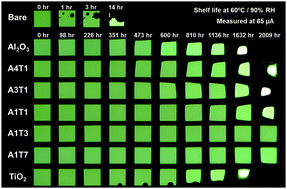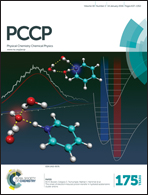Optimization of Al2O3/TiO2 nanolaminate thin films prepared with different oxide ratios, for use in organic light-emitting diode encapsulation, via plasma-enhanced atomic layer deposition†
Abstract
Encapsulation is essential for protecting the air-sensitive components of organic light-emitting diodes (OLEDs), such as the active layers and cathode electrodes. Thin film encapsulation approaches based on an oxide layer are suitable for flexible electronics, including OLEDs, because they provide mechanical flexibility, the layers are thin, and they are easy to prepare. This study examined the effects of the oxide ratio on the water permeation barrier properties of Al2O3/TiO2 nanolaminate films prepared by plasma-enhanced atomic layer deposition. We found that the Al2O3/TiO2 nanolaminate film exhibited optimal properties for a 1 : 1 atomic ratio of Al2O3/TiO2 with the lowest water vapor transmission rate of 9.16 × 10−5 g m−2 day−1 at 60 °C and 90% RH. OLED devices that incorporated Al2O3/TiO2 nanolaminate films prepared with a 1 : 1 atomic ratio showed the longest shelf-life, in excess of 2000 hours under 60 °C and 90% RH conditions, without forming dark spots or displaying edge shrinkage.


 Please wait while we load your content...
Please wait while we load your content...